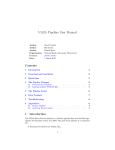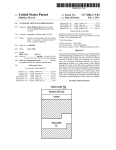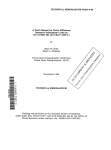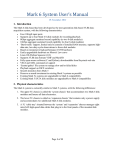Download SPEDE User`s Manual.2
Transcript
SPEDE
A Simple Programming Environment
for
Distributed Execution
Rev 4.0
Jim Gochee, © 1992
Senior Thesis
Dartmouth College
1992
The Author would like to thank the following people for their ideas and support:
David Kotz - Thesis Advisor
Mark Franklin - Thayer School of Engineering
Nicholas Wilt - Fellow '92
Table of Contents
1. SPEDE Overview................................................................. 1
2. SPEDE Installation ............................................................... 3
3. Data Structures..................................................................... 4
4. Programming an Object ........................................................ 6
5. Object Functions..................................................................10
6. Register..............................................................................13
7. Appendix: Sample Programs.................................................15
SPEDE Overview
Traditional single processor computers are quickly reaching their full computational potentials. The
quest for faster and faster chips have brought technology to the point where the laws of physics are
hampering future gains. Significant gains in speed must therefore come from using multiple processors
instead of a single processor. This technology usually represents itself in the form of a parallel computer,
such as the Connection Machine Model 5. Recently however, much interest has been focused on software
that organizes single processor computers to behave like a parallel computer. This is desirable for sites
which have large installations of workstations, since the cost of new parallel systems are prohibitive.
SPEDE, a Simple Programming Environment for Distributed Execution, was designed for this purpose. It
allows UNIX based machines of varying hardware types to be organized and utilized by a programmer of
parallel applications. SPEDE is a user level system in that it requires no special privileges to run. Every
user keeps a separate copy of the system so that security issues are covered by the normal UNIX operating
environment. SPEDE is characterized as a large grained distributed environment. This means that
applications which have a large processing to I/O ratio will be much more effective than those with a small
ratio.
SPEDE allows users to coordinate the use of many computers through a straightforward interface.
Machines are organized by classes, which are terms that can be used to label and group them into more
manageable units. For example, users might want to create a class based on the byte ordering of machines,
or by their location. Users can then specify more completely which machines they want to use for a
particular session. Sessions are essentially the interaction between objects in the SPEDE environment. A
user creates an object to perform a certain task, such as constructing part of a fractal image. Objects can
send and receive messages from other objects using a simple interface provided with SPEDE. Objects are
machine independent, which means that the same object can be run simultaneously on different platforms.
This is achieved by translating all messages into standard network byte ordering. However, if user data is
being passed between objects, it is the user's responsibility to make sure byte ordering is correct.
The SPEDE system involves several major components. These components help control and manage
object interactions. Figure 1 shows a running session running with three machines (each surrounded by an
oval rectangle). There are also three objects running, two named MandComp and one named Mand. Each
object is on a different machine, although it is possible to have multiple objects on a single machine. In the
figure, the lines connecting the various entities represent socket connections. UNIX sockets are the
transport mechanism used in SPEDE, although one could implement a lower level protocol for more
efficient communication. Sockets can also be a problem because some machines have strict limits on the
number of connections a user can have open at any given time.
Warning:
SPEDE should not be run by a priveledged user, nor should priveledged objects be compiled.
Components in the SPEDE system assume a trusted environment, so no authentication is performed. It is
possible for a mal-intentioned user to command someone else’s run-time daemon to launch objects under
the other user’s name. Only objects in the special run time directory can be accessed.
-1-
Everest
Mand
Register
Dean
Dean
Dean
MandComp
MandComp
Haystack
Waumbek
Normal Link
Speed Link
Register Link
Figure 1
Along with the objects, each machine also has a process called the dean. Objects and deans are linked
together with sockets. Every process also has a connection with a process called Register. Register keeps a
table of all running entities such as deans and objects, with the UNIX port number that each can be
reached at. Register is also used to start and stop deans.
The dean process (which runs as a daemon) is the backbone of the SPEDE system. It is the means by
which objects create other objects and the channels through which all object communication passes. Deans
can either be started by the user from Register, or automatically when an object needs to make a connection
to a remote machine (for which a dean must be present). It is more efficient to manually start the deans
before a session begins, since the overhead of automatically creating a dean is quite high. Once the deans
are running, they remain in a passive state waiting for commands from objects. If a dean is idle for more
than 10 minutes, it shuts down. This is desirable in most circumstances because it prevents deans from
reaching a state where they run in forever. If the user does not want the deans to terminate, it is possible to
tell Register to keep the deans alive. Register can also be used to kill running deans.
-2-
SPEDE Installation
SPEDE comes as a tar file called spede.tar. Copy this file into the directory where you want the
SPEDE source to be installed. When this is done, enter the following command to untar the file:
tar -xf spede.tar
SPEDE creates one directory at the level of the tar file named spede. This directory contains the
SPEDE system programs and some sample objects. The only other directory you will need is a binaries
directory. A binaries directory is used to keep the SPEDE executables in a well known place. If a shared
file system is used with machines of differing types, then each type of machine should have its own
binaries directory. One common way to do this is to have a standard root binary directory, such as
~/bin/spede. From there, each type of machine, such as 'sun3' or 'ibm_rs6000' can have its own sub
directory. In order for SPEDE to tell which binaries directory a machine is using, an environment variable
called SPEDE_BIN must be set.
To set SPEDE_BIN when using a shared file system, your system must have some way of determining
its architecture type. The UNIX command "uname -m" is one common way to get this information,
although some systems have different commands. Contact your system operator if you do not know how
to get this information. Note that you must also create the directories described by $SPEDE_BIN .
Example Environment Settings
setenv MACHINE `uname -m`
setenv SPEDE_BIN ~/bin/spede/$MACHINE
Compilation
Once the SPEDE binaries directory has been set up, you are ready to compile. To do this:
1) Change into the SPEDE directory
cd spede
2) Make sure no old object files or binaries are lying around
make clean
3) Compile the system executables and sample objects using the "make" command. NOTE: some of
the sample objects may not compile due to limitations of you local machine.
make install
When you run "make" from the spede directory, binaries for the dean, register, and objects will be
automatically stored in $SPEDE_BIN. This is why it is necessary to set SPEDE_BIN before running "make".
-3-
Data Structures
The interface to SPEDE is provided to the user through C function calls. These calls are implemented
in a special library that is linked in with every object. The following data structures are used throughout the
SPEDE system.
Object Descriptors
Most routines that manipulate objects will take a parameter of type object_instance *. This type
describes how to communicate with the object and contains other pertinent information.
typedef struct{
char name[40];
long addr;
} node_des;
/* Name of remote machine
*/
/* Unix address of remote machine */
typedef struct {
node_des node;
long obj_ref;
} link_des;
/* Remote machine descriptor
/* Ref num to use with remote
*/
*/
typedef struct {
link_des creator;
link_des storesite;
link_des location;
char type[20];
long id;
boolean is_fault_tolerant;
boolean debug;
boolean state;
void *data;
long dean_ref;
} object_instance;
/*
/*
/*
/*
/*
/*
/*
/*
/*
/*
*/
*/
*/
*/
*/
*/
*/
*/
*/
*/
Points to who created the obj
Points where obj is backed up
Points to where obj is running
Ascii name of the object
The object's ID number
Is the object fault tolerant
Is the object being debugged
The state of the object
Used internally
Ref num to use with dean
The type node_des is used to describe a remote machine as a combination of the machine name and
the machine's UNIX address. The type link_des is used to describe an object that has already been
created by a remote dean. The location of the object is given by the node and the reference number of the
object is given by obj_ref. The user need not access the fields of this structure directly since there are
library calls to manipulate the information. The most widely used data type is the object_instance. This
type is returned by the object creation routine and is used in all communications with the object. None of
the fields in this structure should be altered by the user because the SPEDE system stores critical
information here (particularly in the data field).
Object Communication
Communication between objects is done through commands. The underlying SPEDE system uses
many unique commands to control object interactions. The user however, is restricted to using only the
invoke function command. This command tells a remote object to execute a specific user defined
function given a set of parameters passed with the command. The user accesses the obj_message
command through C function calls described later on. When a local object sends a message to a remote
object, the remote object returns a result and optionally some parameters.
#define MAX_PARAMS 20
typedef struct {
void *data;
long len;
} parameter;
/* A pointer to malloced memory */
/* The length of the data
*/
-4-
typedef struct {
short num_params;
parameter param[MAX_PARAMS];
} parameter_block, pblock;
/* How many params are there */
/* An array of parameters
*/
typedef struct {
long status;
long result;
pblock *r_params;
} return_info;
/* Has the message completed yet */
/* What is the return value
*/
/* Return parameters (or NULL)
*/
The parameter_block structure has a set of library routines that are used to manipulate it. The user
may access these fields directly, although this is discouraged. The return_info structure is sent back
from the remote object when the command has finished processing. If no return parameters are used, the
r_params field will be null.
Running Objects
Every object that runs from the UNIX command line has an object_descriptor set up for it. This
descriptor is an interface between the user and the object. Objects will often want to create other objects,
and the descriptor can be used to see where the user wants those objects to run. For example, if the role of
an object called mand is create worker objects to complete a task, then mand would like to know how
many objects to create and on what machines. This could be compiled into the object itself although that
would require recompiling the program every time this information changed. With the object_descriptor,
mand has direct access to the user's command line specifications.
typedef struct {
int num_objects;
char classes[100];
int num_machines;
char **machine;
} object_descriptor;
/*
/*
/*
/*
Default
Default
Default
Default
to
to
to
to
0 */
empty string */
0 */
0 pointer */
The fields of this structure are constructed by SPEDE when the user launches an object with certain
command line parameters. These parameters are described in a section below.
-5-
Programming an Object
A SPEDE object is defined as a set of user functions (and data). The object is a C file compiled into a
standalone program, whose interactions with other objects is controlled by the compiled-in SPEDE library.
The user's functions are accessed through a callback function with a message type. The message type will
indicate to the object which function should be performed. Every function that an object performs will
have a different message number, which must be specified by the user. Message numbers 0-10 are
reserved by SPEDE for sending special messages to an object. These messages include CREATE and
DELETE, which the object can ignore if no special processing is required. The general form of an object
file is:
Header Information
<User Functions>
Message Callback Function
Main
Free Launch
Normal Launch
Each of these sections is described below.
Header Information
The following header files must be included for the object to compile properly. Also, a string called
object_name must be defined with the name of the object.
#include <stdio.h>
#include <sys/types.h>
#include <netinet/in.h>
/* These
#include
#include
#include
#include
#include
include files are necessary for objects */
"sockets.h"
"spede.h"
"spede_io.h"
"objects.h"
"objlib.h"
char *object_name = "template_obj";
User Functions
User functions are the functions written by the user to handle messages. Here is where the actual
computations occur.
Message Callback Function
The message callback function is the glue between SPEDE and an object. Object command messages
received by SPEDE are sent to an object via the callback. The callback routine is chosen by the user and
passed as a parameter when the object is initialized. The callback routine should have the following format:
static long MyCallback(short message, pblock *params, block **rparams);
The function to be performed is indicated by message. Parameters to the function are sent in
params. If there are any return parameters, rparams is used. Either params or rparams can be NULL,
indicating no parameters. A typical callback looks something like this:
static long callback(short message, pblock *params, pblock **r_params)
{
-6-
long result;
r_params = NULL;
/*
switch(message) {
/*
case CREATE:
/*
break;
case DELETE:
/*
break;
case user_message1:
result = my_function(params);
/*
break;
case user_message2:
result = my_function2(params, r_params);
break;
default:
result = 0 ;
break;
}
return(result);
Null unless we set elsewhere */
Which message were we sent? */
Allows object to alloc mem
*/
Tell object to shut down
*/
Don't need to use r_params
*/
/* This uses r_params
*/
}
Main
The main function of the object file is shown below. The user should not put any other code here.
When an object starts up, the SPEDE library will call one of two user functions which should be used by
the user instead of main. These two functions are described in the next section. The third parameter to the
function init_objects is the address of the callback function from the previous section.
main(int argc, char **argv)
{
if (init_objects(argc, argv, callback)) {
perror("Error trying to initialize the object library");
exit(1);
}
register_dean();
/* Connect into the SPEDE network */
}
Free Launch
When an object is started up, the SPEDE library will call one of two routines in the object file. If the
object was started from the command line (known as a free launch), the function 'free_launch' is called.
If the object was started by a dean in response to a creation command, then 'normal_launch' is called.
These routines give the user a chance to set up configuration info, which would have normally been done
in main. The format of the free_launch command is:
static void free_launch(int argc, char **argv);
Normal Launch
When an object is started by a dean (in response to a creation command from another object), the
routine normal_launch is called. Like the function free-launch, normal_launch gives the user a
chance to set up an configuration information.
static void normal_launch(void);
-7-
Sample
A sample object, which does nothing but show the framework of an object, is given below:
/* Sample Object */
#include <stdio.h>
#include <sys/types.h>
#include <netinet/in.h>
#include
#include
#include
#include
#include
"sockets.h"
"spede.h"
"spede_io.h"
"objects.h"
"objlib.h"
/* These include files are necessary for objects */
char *object_name = "MyObject";
void initialize()
{
}
/* Allocate memory */
void deallocate_mem()
{
}
/* Deallocate memory */
long do_work1(pblock *params)
{
return(0);
}
/* Do some work */
static long callback(short message, pblock *params, pblock **r_params)
{
long result = 0;
r_params = 0L;
switch(message) {
case CREATE:
initialize();
break;
case DELETE:
deallocate_mem();
break;
case MESSAGE1:
result = do_work1(params);
break;
}
return(result);
/* I never have r_params */
/* Set up some memory
*/
/* Free the memory
*/
/* Do some work
*/
}
main(int argc, char **argv)
{
if (init_objects(argc, argv, callback)) {
perror("Error trying to initialize the object library");
exit(1);
}
register_dean();
/* Connect into the SPEDE network */
}
void free_launch(int argc, char **argv)
{
printf("ERROR!!! You cannot start this object from the command line\n");
exit(0);
}
void normal_launch()
{
/* We allocate memory when the CREATE message is received, but we could
* do it here instead.
*/
}
Compilation and Makefiles
For an object to work in the SPEDE environment, it must be linked to the correct library file. Shown
below is a sample Makefile that will correctly build an object.
# Makefile to compile an object, SPEDE_BIN should be an environment variable
LIB = $(HOME)/spede/lib
INCLUDE = $(HOME)/spede/include
CFLAGS = -I$(INCLUDE)
MY_OBJS = myobject.o $(LIB)/objlib
# Links the correct library
-8-
myobject: $(MY_OBJS)
$(CC) $(CFLAGS) -o myobject $(MY_OBJS)
install:
cp mand $(SPEDE_BIN)
# A well known location for objects
Command Line Parameters
The following options can be used on the command line when launching an object:
-
h
p
n
c
m
f
<hostname>
- Specifies the hostname of the Register process
<port number> - Specifies the port number of the Register process
<number objects>
- Specifies the number of objects to create
<class list> - Specifies which machines to create objects on (by class)
<machine list>
- Explicitly specifies which machines to create objects on
<file name>
- Lists a file that has the object information.
Every object that runs must connect with a Register process. There are two ways this can be
accomplished. One is by the user specifying the location of a Register process from the command line.
This is done with the -h and -p options. If these options are not present, then the object attempts to read the
file '~/.reginfo'. This file should contain a hostname and port for the last running Register. If that Register
is still running, then the object connects. If not, then the object aborts and the user has to start a new
Register.
The other command line options give an object hints about what other machines to use. These options
will set the run_info global variable, whose structure was defined earlier. The object can choose to use
these user hints, or ignore them and use its own information. The format for the file used in the -f option
is:
# This is an object_info file
# Number of objects to create
5
# Class descriptors
rs6000#dec
# Machine descriptors
polaris
If the user specifies both machines and classes, SPEDE will combine the resulting machine list into
one list. The ordering of the list gives the specified machines priority over the class chosen machines. If
the user does not specify the number of objects to use, SPEDE sets that to be the number of machines that
were specified (by the -m and -c parameters).
Example
mand -h polaris -p 4055 -n 10 -c rs6000
mand -c rs6000
The first example starts the object mand and tells it to use the Register process located on the machine
'polaris' at port number 4055. Ten objects are recommended to mand. These objects should run on
machines of the class rs6000. The second example assumes that the file '~/.reginfo' exists, so no
Register information is given. Machines of the class rs6000 are to be used, and since there are no
specified number of objects to use, one object will be used for each machine.
-9-
Object Functions
Objects are able to function and communicate with other entities in the SPEDE system by a special
library that is linked in with each object. This object library offers an array of function calls to allow an
object to interact with other objects. The types of calls are broken down into the following categories:
• Initialization
• Creating/Deleting objects
• Parameter Blocks
• Sending messages to objects
• Miscellaneous calls
Initialization
The main function of the object file (which has a fixed format) uses two functions to connect with the
SPEDE library. The format for these are:
int init_objects(int argc, char **argv, void *function_callback);
void register_dean(void);
Global Variables and Defines
#define OBJECT_OK
#define CREATING_OBJECT
0
1
#define
#define
#define
#define
-100
-101
-102
-103
INVALID_REMOTE
INVALID_OBJECT
NETWORK_ERROR
CREATION_TIMEOUT
/* SPEDE error messages */
int SpedeError;
/* Set after each SPEDE library call */
Creating and Delete Objects
There are two ways to create an object, synchronously or asynchronously. If the object is created
synchronously, the call blocks until the remote object has been created. This can be a long wait, especially
if the remote machine does not have a dean running on it. A more efficient approach is to create the object
asynchronously. This requires one more function call to wait until all asynchronous objects have been
created.
object_instance *create_object(char *machine_name, char *type, boolean debug,
boolean is_fault_tolerant, boolean async);
int sync_created_objects();
int get_object_status(object_instance *object);
int delete_object(object_instance *object);
object_instance *link_object(link_des *remote_link);
object_instance *speed_link(link_des *remote_link);
Create_object will communicate with the SPEDE network to create the specified object on the given
remote machine. If async is true (non zero), then the call will return immediately even though the returned
object_instance will not be valid until the object has been created and verified.
Sync_created_objects should be called before accessing any asynchronously created object. If an error
occurred while creating a synchronous object, the return value will be NULL and SpedeError will
- 10 -
contain the error number. If an error occurs when an object is created asynchronously,
sync_created_objects will return false (0). The user must then check the status of each object to see
which one(s) could not be created. This is done with the get_object_status routine.
Get_object_status will return either OBJECT_OK, CREATING_OBJECT, or one of the SPEDE error
messages.
Call delete_object to terminate an object. The object_instance pointer is freed and a delete
message is sent to the remote object. This call blocks until the object has been deleted, or an error occurs.
The return value will be OBJECT_OK, or one of the SPEDE error messages.
Link_object and speed_link allow access to an object from an object's link descriptor (link_des).
This descriptor gives the host information and object reference number for a given object, which can be
gotten from the location field of an object_instance. These routines are provided to allow child
objects to communicate amongst themselves. For instance, object A creates two child objects, B and C. A
then wants B and C to send messages back and forth. For this to happen, B and C must be told of each
others existence. This is done by passing B and C a link descriptor for each other, at which point they can
form a link using link_object. They can then communicate over the link as if they had created the object
themselves. A speed link is a variation on link_object. It is used to bypass the remote object's dean.
This will cut down on network overhead, although the in future, the object will lose the ability to be
debugged and kept fault tolerant (to be implemented).
Example
/* Create two objects. Return 0 if call completed, or error code
* if call failed.
*/
int my_create_objects(object_instance **object1, object_instance **object2)
{
*object1 = create_object("everest", "MandComp", FALSE, FALSE, TRUE);
*object2 = create_object("haystack", "MandComp", FALSE, FALSE, TRUE);
return(sync_created_objects());
}
Parameter Blocks
Parameters are used when objects have data to send to one another. Parameter blocks can be
manipulated with several SPEDE routines.
pblock *new_params(int num_parms, long param1 size,...);
void set_params(pblock *p, void *p1data, ...);
void get_params(pblock *p, void **p1data, ...);
void free_params(pblock *p);
To create a new pblock structure, use new_params. The first parameter to new_params is the
number of parameters to reserve in the pblock. Each parameter after that will describe the size in bytes for
every parameter in the pblock. To assign values into a pblock structure, use set_params.
Set_params takes as its first argument the pblock to work with. The next arguments are pointers the
data of the parameters, which set_params copies into the parameter block. It knows the size of each
parameter from the new_params call. Get_params works in the other direction. It assigns user
variables to point to its internal data for each parameter. Use free_params to deallocate memory
associated with a parameter block.
Sending Messages
- 11 -
Objects communicate amongst themselves by sending each other 'messages'. These messages are
integer values representing a certain function to be done. When an object sends a message to another
object, a return message is sent unless the user instructs SPEDE to ignore the return.
return_info *send_obj_message(object_instance *object, short message,
pblock *params, boolean async, boolean send_return);
int send_obj_mess_callback(object_instance *object, short message,
parameter_block *params, void *callback, void *data);
The simplest call to use when communicating with another object is send_obj_message. It takes the
destination object as the first parameter, followed by a message number, some parameters, and then
async and send_return. Async, if true, will force the call to return immediately. The user must then
poll the status filed of the return_info structure. The status field will be set to 0 if the call is completed, 1
if the call is still in progress, or a negative number if an error occurred. If send_return is set to false, in
which case the user expects no return value, the routine returns immediately with NULL for the
return_info. There is no way to know when the remote call completes send_return is false.
Spede Idle
In order for SPEDE to get processing time to check for object messages, the user must periodically call
idle_objects. This is actually only necessary if the user is expecting data. The interface to idle_objects
allows the user to specify a MAXIMUM time given to SPEDE for processing object commands. The
routine will return earlier than the specified time however after processing a single command. This allows
the user to call idle_objects, then check a return status value to see if an outstanding call has completed.
void idle_objects(int secs, int usecs);
The two parameters specify how long idle_objects should wait if no incoming messages exist.
Example
r_info = send_object_message(obj, DO_WORK, params, TRUE, TRUE);
while(r_info->status == 1)
idle_objects(1000, 0);
/* While call is outstanding
/* Wait for return message
*/
*/
Miscellaneous
The miscellaneous routines are as follows:
void reset_times(object_instance *object);
void get_object_times(object_instance *object, double *idle, double *cpu,
double *writing);
These two routines allow the user to reset the internal timing info of an object, and get the timing info
at a later time. Time values are in seconds. Idle time expresses the seconds spent idle (i.e., waiting for
something to do). The cpu time is the time spent within an object_message call, which means the object is
doing work. The writing time measures how many seconds the object spent writing return data.
Sample Objects
To see some sample objects, refer to the Appendix of this paper.
- 12 -
Register
The Register application must be running at a known location before any other of the SPEDE
components can function. The reason for this is that only Register will know how to contact remote
machines. Without Register, a user would have to manually run deans on every remote machine and keep
track of their port numbers. If the Register process dies for any reason, all running deans will loop trying
to connect. If a Register process is then re-started, the remote deans will automatically connect.
SPEDE components, including the dean and all objects, get the location of Register by either reading a
configuration file in the user's home directory, or by getting the information from the command line. The
second option is always used when Register itself launches a remote object or dean. If the user launches an
object from the command line, SPEDE first looks to see if the user provided the Register information. If
not, SPEDE attempts to find a Register process by reading a file named '~/.reginfo'. This file is written by
a Register process each time it is started. The file has information about where and on what port the
Register process is running. The format for the file is (although the user need not alter this file):
#This is .reginfo
everest.cs.dartmouth.edu
4056
# Machine name
# Port number
To run the Register, simply cd to the correct binaries directory for the machine you are on (or have that
binaries directory in your PATH). The simply type 'reg' on the command line. Register then starts up and
reads the '~/.reginfo' file. It attempts to open a listening socket on the specified port. If it cannot open a
socket on that port, it asks the user if it should use a new port number. The reason you might want to keep
using the last port that Register used is because there may still be deans running. The deans keep trying to
connect to Register, but they only try the old port number. If Register runs on a new port, any currently
running deans will not be able to find it. The deans eventually give up after 10 minutes if they cannot
reconnect to Register.
Register Commands
The following user commands are implemented in Register:
• show
• machines
• start
• stop
• tickle
• quit
• help (?)
show - Use this command to print all currently connected deans and objects.
machines - Use this command to print all machines known to Reg.
start dean <machinelist | classlist> - Use this to start deans on remote machines. The
machines on which the deans will be started can be specified by a machinelist descriptor or a classlist
descriptor. A machinelist descriptor is one or more machine names separated by the '#' character.
Example, start dean everest#haystack. A classlist is similar to a machinelist except that machine classes are
specified. Example, start dean dec#b105. This would launch deans on all machines which are in class dec
and in class b105. Note that a wild card '*' can also be used to name all machines or all classes.
stop dean <machinelist | classlist> - Use this to stop deans. This is usually done after a
session is complete. The machinelist and classlist specifiers are the same as for start dean, and all deans
can be stopped with 'stop dean *'.
- 13 -
tickle <on | off> - deans can be tickled every minute to keep them alive, if the user sets this to
'on'. If deans are not tickled and they do not receive input for 10 minutes, they will exit. This keeps them
running while the user is doing other things like editing code or compiling. Tickle is off by default.
quit - Closes all connections and exits. Note that due to limitations of UNIX sockets, some
sockets may remain open for a while after Register quits. This may inhibit Register from running again
soon after quitting. The connected deans are not shut down, rather they are left running until Register
starts up again, or until the 10 minute time-out is reached.
help - Gives these command descriptions on-line.
Reg machine file
When Reg launches, it looks for a special file in the user's home directory called '.reg.machines'. This
file contains information about all machines that are going to interact in the SPEDE system. The format for
this file is shown below. Lines with '#' as the first character are ignored.
#This is ~/.reg.machines
%classes
# We are defining some classes
rs6000
# Class of IBM machines by model type
ibm_rt
dec
# Class of machine by manufacturer
b105
# Class of machine by the room they live in
#
%machines
# Valid machines
#
# machine information is listed as:
# <machine_name>, classes, base directory for deans and objects
everest, dec|b105, prog
waumbek, dec|b105, prog
#
turing, rs6000, rs6000/prog
babbage, rs6000, rs6000/prog
northstar65, ibm_rt, rt/prog
Problems with Reg
Reg is able to launch remote deans through the UNIX 'rsh' program. Sometimes this program hangs
without launching the remote dean. The side effect of this is that sockets will remain open and the Reg will
not be able to run again. To fix this, the user must do a 'ps -ux' to find out if any 'rsh' commands are
outstanding. If they are, the user should kill the processes using 'kill -9 <proc id>'. This is a bug in rsh.
- 14 -
Appendix: Sample Objects
The following program is a computational object for producing a Mandelbrot image.
/* MAND_COMP
* Jim Gochee
* 5/10/92
*
* This object is a mandelbrot computation object. It is accessed from a 'mand'
* object. Mand_comp will allow 'mand' to assign it part of an image to
* compute.
*/
#include <stdio.h>
#include <sys/types.h>
#include <netinet/in.h>
/* Include files necessary for objects */
#include "sockets.h"
#include "spede.h"
#include "spede_io.h"
#include "objects.h"
#include "objlib.h"
#define
#define
#define
#define
TRUE 1
FALSE 0
SET_JOB
START_TASK
10
11
/**
** Mandelbrot types
**/
struct mandel_task {
int width, height;
double left, right, top, bottom;
double cr, ci;
};
struct mandel_job {
int left, right, top, bottom;
int width, height;
unsigned char *pixels;
int x,y;
};
/**
** Globals
**/
char *object_name = "mand_comp";
struct mandel_job *job;
struct mandel_task our_task;
int obj_num;
/* What is the name of the object */
/* Our object number */
/**
** Mandelbrot computation functions
**/
int mandel_do_pix(task, job)
struct mandel_task *task;
struct mandel_job *job;
{
double rx, ry;
rx = task->left + ((task->right - task->left) * (double) job->x) / (double) t
ask->width;
ry = task->top + ((task->bottom - task->top) * (double) job->y) / (double) tas
k->height;
job->pixels[(job->y - job->top)*job->width + job->x - job->left] = mandel(rx,
ry, task->cr, task->ci, 256, 1);
if (++job->x == job->right) {
job->x = job->left;
job->y++;
if (job->y > job->bottom)
return 1;
}
return 0;
}
int
mandel_do_job(task, job)
struct mandel_task *task;
struct mandel_job *job;
{
do
if (mandel_do_pix(task, job))
return 1;
- 15 -
while (TRUE);
return 0;
}
/* mandel.c: mandelbrot routine
* From Fractint public domain fractal-manipulation program.
*/
int
mandel(initreal,initimag,parm1,parm2,maxit,inside)
double initreal,initimag,parm1,parm2;
int maxit,inside;
{
double oldreal, oldimag, newreal, newimag, magnitude;
int color;
oldreal=parm1;
oldimag=parm2;
magnitude = 0.0;
color = 0;
while ((magnitude < 4.0) && (color < maxit)) {
newreal = oldreal * oldreal - oldimag * oldimag + initreal;
newimag = 2 * oldreal * oldimag + initimag;
color++;
oldreal = newreal;
oldimag = newimag;
magnitude = newreal * newreal + newimag * newimag;
}
if (color >= maxit) color = inside;
return(color);
}
/* SET_JOB
*
* This routine is called when a 'set_job' message is received.
*/
void set_job(params)
pblock *params;
{
char *task;
int *start, *stop;
struct mandel_task *t = &our_task;
int *t_obj_num;
get_params(params, &t_obj_num, &task, &start, &stop);
*start = ntohl(*start);
*stop = ntohl(*stop);
obj_num = *t_obj_num;
/* Get the task description out of the string */
sscanf(task, "%d %d %lg %lg %lg %lg %lg %lg", &t->width,
&t->height, &t->left, &t->right, &t->top,
&t->bottom, &t->cr, &t->ci);
job->left = 0;
job->right = job->width = t->width;
job->top = *start;
job->bottom = *stop;
job->height = (*stop - *start + 1);
job->x = 0;
job->y = *start;
job->pixels = (unsigned char *) malloc(job->width * job->height * sizeof(unsig
ned char));
printf("(%s %d) Will compute from %d to %d\n", object_name, obj_num, *start, *
stop);
}
/* DO_WORK
*
* This routine is called when the a 'start_task' message has been received.
*/
void do_work(params, r_params)
pblock *params, **r_params;
{
pblock *results;
long k;
mandel_do_job(&our_task, job);
/* Compute the image section */
/* Allocate return parameters */
results = new_params(2, sizeof(long), job->width * job->height);
k = htonl(job->top);
set_params(results, &k, job->pixels);
*r_params = results;
}
static long callback(message, params, r_params)
- 16 -
int message;
parameter_block *params, **r_params;
{
long result;
parameter_block param;
char rw_des[256];
param.num_params = 0;
if (r_params != 0)
*r_params = ¶m;
switch(message) {
case CREATE:
job = (struct mandel_job *) malloc(sizeof(struct mandel_job));
break;
case DELETE:
break;
case SET_JOB:
set_job(params);
sprintf(rw_des, "%s%d", object_name, obj_num);
break;
case START_TASK:
printf("Start computation.\n");
do_work(params, r_params);
printf("Done with computation.\n");
break;
default:
printf("Invalid message.\n");
return(0);
}
}
main(argc, argv)
int argc;
char **argv;
{
if(init_objects(argc, argv, callback)) {
perror("Error in init_objects");
exit(1);
}
register_dean();
/* Tell local dean we exist */
}
void free_launch(argc, argv)
int argc;
char **argv;
{
/* Free launch comes here */
printf("ERROR!!! This object cannot be free-launched\n");
exit(0);
}
void normal_launch()
{
/* Nothing to do */
}
This sample is the mandelbrot organizer. It creates worker objects and reconstructs the return
image fragments.
/* MAND
* Jim Gochee
* 5/10/92
*
* This object, when used with the PDPE (Personal Distributed Programming
* Environment) will draw a mandelbrot image utilizing multiple cpus.
*/
#include <stdio.h>
#include <sys/types.h>
#include <netinet/in.h>
/* Include files necessary for objects */
#include "sockets.h"
#include "spede.h"
#include "spede_io.h"
#include "objects.h"
#include "objlib.h"
/* Non-necessary include files */
#include "misc.h"
#define
#define
#define
#define
TRUE 1
FALSE 0
MAX_OBJECTS 100
ZOOM_FACTOR 2.5
/* The closer to 2, the bigger the zoom */
#define LINE_INC 10
- 17 -
#define SET_JOB
#define START_TASK
10
11
/* Object messages */
/**
** Some typedefs describing the image and what a 'job' is.
**/
struct mandel_task {
int width, height;
double left, right, top, bottom;
double cr, ci;
};
struct mandel_job {
int top, bottom;
};
char *object_name = "mand";
object_instance *task_obj[MAX_OBJECTS];
unsigned char *final_pix;
struct mandel_task g_task;
int end_line, current_line, num_working;
pblock *params;
int num_machines;
int num_objects;
char class_name[256];
/*
/*
/*
/*
/*
/*
/*
/*
/*
This name is the object name */
An array of object pointers */
Pointer to the image in memory */
The mandelbrot descriptor
*/
Used to monitor image lines */
Params for work objects
*/
The num of available nodes
*/
The num of work objects in use */
Which classes to use
*/
/* CALLBACK
*
* This routine is the callback for when an object receives a OBJ_MESSAGE
* command. This object will never receive one of those, so this routine is
* not used.
*/
static long callback(message, params, r_params)
int message;
parameter_block *params, **r_params;
{
long result;
parameter_block param;
param.num_params = 0;
if (r_params != 0)
*r_params = ¶m;
switch(message) {
case CREATE:
break;
case DELETE:
break;
default:
printf("Invalid message.\n");
return(0);
}
}
/* MAIN
*
* This is the same for every object.
*/
main(argc, argv)
int argc;
char **argv;
{
if(init_objects(argc, argv, callback)) {
perror("Error in init_objects");
exit(1);
}
register_dean();
/* Tell local dean we exist */
}
/* INIT_TASK
*
* This routine sets up the mandelbrot image to be computed.
*/
void init_task(task)
struct mandel_task *task;
{
long size;
task->width = 1024;
task->height = 768;
/* task->left = -2.5;
task->right = 1.5;
task->top = -1.5;
task->bottom = 1.5;
- 18 -
*/
task->left = -0.6633725;
task->right = -0.6533721;
task->top = -0.45337413;
task->bottom = -0.4458738;
task->cr = 0;
task->ci = 0;
size = task->width * task->height * sizeof(unsigned char);
final_pix = (unsigned char *) malloc(size);
}
/* CREATE_OBJECTS
*
* This routine is responsible for creating the work objects to compute the
* actual image. The machines that will be used are gotten from the command
* line in the form of a class name. The 'reg' daemon is queried to find out
* which machines are available in the given class. Note that machine names
* could also have been entered on the command line with or in place of a
* class name. Using a class name only is a choice made by the object and not
* the restriction of the underlying mechanism.
*/
void create_objects()
{
char *machine;
int k, m, err;
object_instance *obj;
link_des link;
char **the_machines;
extern object_descriptor run_info;
printf("Creating the work objects\n");
/* Query the 'reg' daemon for machines of the given class */
num_machines = run_info.num_machines;
printf("Create objects on %d machines\n", num_machines, class_name);
num_objects = (run_info.num_objects > MAX_OBJECTS) ? MAX_OBJECTS :
run_info.num_objects;
printf("Attempting to creating %d objects\n", num_objects);
m = 0;
for(k=0; k < num_objects;) {
if (num_machines < 1) {
printf("There are no machines specified!!\n");
exit(0);
}
machine = run_info.machine[m % num_machines];
printf("Asynchronously creating mand_comp on machine '%s'\n", machine);
task_obj[k] = create_object(machine, "mand_comp", FALSE, FALSE, TRUE);
if (task_obj[k] != 0) {
k++;
}
else {
run_info.machine[m] = run_info.machine[num_machines-1];
num_machines--;
}
m++;
}
num_objects = k;
if (num_objects < 1) {
printf("There are no objects\n");
exit(0);
}
err = sync_created_objects();
/* Wait until all are created */
if (err) {
printf("There was an error creating an object!!!\n");
}
printf("%d objects were actually created\n", num_objects);
for(k=0; k < num_objects; k++) {
/* These next lines form a speed link, which bypasses the dean */
link = task_obj[k]->location;
/* Link to the object location */
task_obj[k] = speed_link(&link);
/* Form the link
*/
}
}
/* OBJECT_DONE
*
* This routine is called by the object library when a return message has
* arrived.
*/
void object_done(object, rinfo, obj_num)
object_instance *object;
return_info *rinfo;
long obj_num;
{
- 19 -
int *p_start, start, stop, pix_start;
struct mandel_task *task = &g_task;
void *data;
long len;
get_params(rinfo->r_params, &p_start, &data);
get_param_len(rinfo->r_params, 0, &len);
pix_start = start = ntohl(*p_start);
memcpy(final_pix + start*task->width, data, len);
/*
printf("Object %d is done with %d to %d\n", obj_num, start,
start+len/task->width); */
/* See if there is more work to do */
if (current_line < end_line) {
stop = current_line + LINE_INC;
if (stop > end_line)
stop = end_line;
start = current_line;
current_line = stop;
object_work(obj_num, object, params, start, stop);
}
else {
num_working--;
/* One less object is working */
}
draw_pixmap(final_pix + pix_start*task->width, 0, pix_start, g_task.width, len
/task->width);
}
/* OBJECT_WORK
*
* This routine is called when some work is being sent to an object.
*/
object_work(k, object, params, start, stop)
int k;
object_instance *object;
pblock *params;
int start, stop;
{
int *start_p, *stop_p, *obj_num;
/* Get pointers to the param data */
get_params(params, &obj_num, 0, &start_p, &stop_p);
*obj_num = k;
*start_p = htonl(start);
*stop_p = htonl(stop);
/*
/* Object number */
/* Starting line */
/* Ending line */
printf("Assigning object %d image line %d to %d\n", k, start, stop);
*/
/* Send this message with no return expected */
send_obj_message(object, SET_JOB, params, TRUE, FALSE);
/* Send the command to start work, with a callback when the return */
/* message arrives
*/
send_obj_mess_callback(object, START_TASK, params, object_done, (void *) k);
}
/* MANDEL_DO_TASK
*
* This routine is called to start the computation of the image.
*/
void mandel_do_task(task)
struct mandel_task *task;
{
char task_string[256];
struct mandel_job job;
int k, start, stop, *start_p, *stop_p, *obj_num, num_completed;
double start_time;
double idle, cpu, writing;
start_time = get_seconds();
/* Start timing the draw */
/* Build the task descriptor, which happens to be an ascii string */
sprintf(task_string, "%d %d %.18g %.18g %.18g %.18g %.18g %.18g",
task->width, task->height, task->left, task->right, task->top,
task->bottom, task->cr, task->ci);
end_line = task->height-1;
params = new_params(4, sizeof(int), strlen(task_string)+1, sizeof(int), sizeof
(int));
set_params(params, 0, task_string, 0, 0);
current_line = 0;
num_working=0;
for(k=0; k < num_objects; k++) {
/* Which image line are we on */
/* The number of objects working */
- 20 -
if (current_line+LINE_INC > (end_line+1)) {
printf("WARNING...not all objects have a section to work on\n");
break;
}
current_line += LINE_INC;
reset_times(task_obj[k]);
/* Reset internal object timer */
object_work(k, task_obj[k], params, current_line - LINE_INC, current_line);
num_working++;
}
while(num_working) {
idle_objects(20, 0);
}
/* Work until all objects done */
printf("Time taken to draw pict was %.5g seconds\n", get_seconds() - start_tim
e);
for(k=0; k < num_objects; k++) {
get_object_times(task_obj[k], &idle, &cpu, &writing); /* Get internal timin
g info */
printf("Object %d: %.4g secs idle, %.4g secs writing, and %.4g secs computin
g\n", k, idle, writing, cpu);
}
/* Don't actually delete objects, since another image might be generated */
/*
printf("All objects have completed.\n");
printf("Deleting all objects\n");
for(k=0; k < num_objects; k++)
delete_object(task_obj[k]);
*/
}
/* ZOOM_TASK
*
* This routine zooms in on a portion of the image.
*/
void zoom_task(x, y, task, direction)
int x, y;
struct mandel_task *task;
int direction;
{
float width, height;
float x_rat, y_rat, difx, dify;
width = task->right - task->left;
height = task->bottom - task->top;
x_rat = width / (float) task->width;
y_rat = height / (float) task->height;
difx = (x - (task->width/2)) * x_rat;
dify = (y - (task->height/2)) * y_rat;
task->left += difx + (width/ZOOM_FACTOR)*direction;
task->right += difx - (width/ZOOM_FACTOR)*direction;
task->top += dify + (height/ZOOM_FACTOR)*direction;
task->bottom += dify - (height/ZOOM_FACTOR)*direction;
}
/* FREE_LAUNCH
*
* This routine is called if the image was launched from the command line.
*/
void free_launch(argc, argv)
int argc;
char **argv;
{
FILE *fp;
int red[256], green[256], blue[256];
int i, x, y, button;
char line[256];
extern object_descriptor run_info;
fp = fopen("mapfile", "r");
if (fp == 0) {
perror("Could not find mapfile...\n");
exit(1);
}
for(i=0; i < 256; i++) {
if (!fgets(line, 255, fp)) {
fclose(fp);
- 21 -
printf("err");
exit(1);
}
sscanf(line, "%d %d %d", red+i, green+i, blue+i);
}
fclose(fp);
init_task(&g_task);
setup_window(argc, argv, red, green, blue, g_task.width, g_task.height);
create_objects();
mandel_do_task(&g_task);
while(1) {
go_picture(final_pix, g_task.width, g_task.height, &x, &y, &button);
zoom_task(x,y, &g_task, button);
mandel_do_task(&g_task);
}
}
/* NORMAL_LAUNCH
*
* This routine is entered when an object is created from another object.
* Mand does not allow this, so exit if it happens.
*/
void normal_launch()
{
printf("ERROR!!! This object must be launched from the command line\n");
exit(0);
}
- 22 -






































